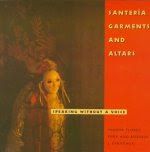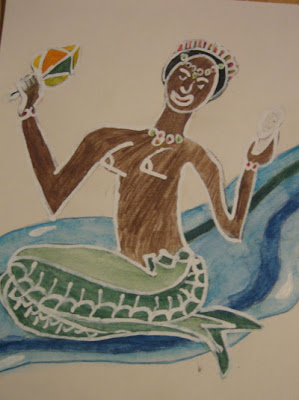Viewing: Blog Posts Tagged with: Yoruba, Most Recent at Top [Help]
Results 1 - 3 of 3
Blog: Creative Cup Illustrators Group (Login to Add to MyJacketFlap)
JacketFlap tags: dog, pets, cat, copy, copycat, Add a tag
Blog: Monday Artday (Login to Add to MyJacketFlap)
JacketFlap tags: goddess, beauty, Yoruba, Add a tag
Blog: La Bloga (Login to Add to MyJacketFlap)
JacketFlap tags: poetry, community building, ritual, National Poetry Month, Nuyorican, Acentos, Yoruba, worship, Santeria, Add a tag

Santeria Garments and Altars is a literate, accessible, beautifully photographed book by a man who is a member/initiate in a house of Oshun. Its subtitle is, ‘Speaking Without A Voice.’ How appropriate! The emphasis is the striking photographs of the variety of altars to the different deities, members of a variety of houses preparing for, or engaged in aspects of worship.
By way of background information -- A ‘house’ is a group of devotees of a particular god or goddess under the leadership of a ‘babalawo’, or priest/priestess. Oshun is another one of the Seven African Powers who represents the archetypical female principle and the power of eros. Interestingly enough, abstinence or asexuality, and a virginal principle of female sexuality has no icon, nor any particular social importance.
Another interesting feature is that the author is a male practitioner, much in the tradition that the gods choose individuals to serve them regardless of gender. My own Catholic upbringing was full of gender separation, nuns as brides of Christ, servants of the male hierarchy, etc. While there are some tasks separated by sex, it does not appear to be as rigid, as attenuated as in a Christian/Catholic context.
One off the major tenets of this religious practice is the construction of altars, which every believer is required to do. There’s a synthesis between aesthetic and spiritual significance. It is considered one’s duty to create, as service to the deity to whom one has pledged oneself. A further illustration of the nexus between creativity and belief is the Santeria/Yoruba belief in ‘ache’, the universal life force present in all things. Each devotee is assumed to have within them the power to create a beautiful altar, one infused with ‘ache.’
In my performance pieces, there are ‘anchor ‘ points--static elements that have life infused into them. (In REM/Memory, there is a central, supine figure, hidden in a mass of blankets, who comes alive as the piece starts, and the nightmare begins. In Resurgam, a chaos of white fabric is stripped away to reveal a captive figure who finds release as the piece begins.) I see a similarity between a finished altar containing ‘ache,’ and a performance’s ‘anchor’pieces being the place where it all comes alive, more specifically, where it reflects at least the possibility of sacred ritual.
There are several points of connection for me here. When the author created an altar to Oshun, it was clear that it could also be seen as a ‘site-specific installation.’ Size of the space, mood of the space, prominent observation points are all taken into consideration. These are the same consideration I make with each piece, the same considerations any installation artist might make.
In the design of an altar dedicated to Oshun, ‘found’ elements are brought into the piece that symbolize her attributes. Since Oshun represents eros, obvious choices illustrate sensuality. Honey, honeycombs, silks and laces are standard items in such an altar. I constantly bring found items from daily life into my performances, hoping to create common imagery for myself and the audience as it unfolds as a shared experience. In Resurgam, during the 'communion’ section, I offer a papaya sliced in half to the audience, sharing its womb shape with them as the symbol of The Living Body--juicy, ripe, the source of all things, ever replenishing.
Lastly, I want to comment on the Santeria idea of ‘coolness.’ Essentially, it is the principle of balance, harmony, a reflection of the connectedness of all things. An altar, no matter how ornate, is not considered ‘cool’ if it does not have these attributes.
Even though my approach is spare, I try to layer things enough to suggest complicated ideas and experiences. It's work with a a consistent point of view, root motifs that I communicate to the audience, an arc of interconnectedness between myself, how I tell the story, the audience, and a unifying force that exists in the moment of performance, a force that I call Spirit.

Dr. Flores-Peña was born in San Juan, Puerto Rico. Studies: University of Puerto Rico, B.A, Catholic University of Puerto Rico, MA. Ed. UCLA M.A and Ph.D. Publications and lectures on Afro-Caribbean Ritual Art and Afro-Cuban religious cultures and Latino Folklore. Lecturer at WAC, Center for Afro-American Studies, and Adjunct Professor at Otis College of Art and Design.
ISBN-10: 087805703X
ISBN-13: 978-0878057030
Lisa Alvarado





Whatever you decide, these two guys are adorable! I love the exasperated look on that cat's face...like, what NOW??? This is beautiful :)
what a fun idea to work with. love it! can't wait to see what you do with it!
teri
This is wonderful. You have the cats expression perfect and the dog looks like a typical dog wanting to please. Great job.
Becky
hahaha, cute!
love it. Could you tell me what medium you used. I like the brushy effect in the background.
This is FANTASTIC Sarah! I love it. Great colours and very original concept! I really like the texture in this too. What do you use for your linework?
Other ideas for animals imitating others:
A bunny imitating a kangaroo? (of course I would come up with that living in Australia) - but could have the bunny strapping a pocket to his tummy.
Some animal imitating a raccoon? (wearing a mask)
a small bird imitating an owl (trying to turn head backwards)
something imitating an ostrich (sticking head in the sand)
oh I could come up with so many of these...! Does this help?
Thanks guys! Glad you like it :0) These are TERRIFIC ideas Lil Kim, thanks so much for your help!! You are on a roll, I can't wait to start drawing some of these up!
The background is acrylic, with an oil glaze over it. I added a soft pencil over the acrylic and the oils to give it more texture. And I outlined with colored pencil, too.
Thanks again everybody!!!
-Sarah
Sarah,
Sorry it's taken me a while to check in. This piece has a really nice combination of atmosphere and playfulness! I like the colors alot. I look forward to seeing more of them!
Kim
They are so cute. Nice work and I love the color. Great work.